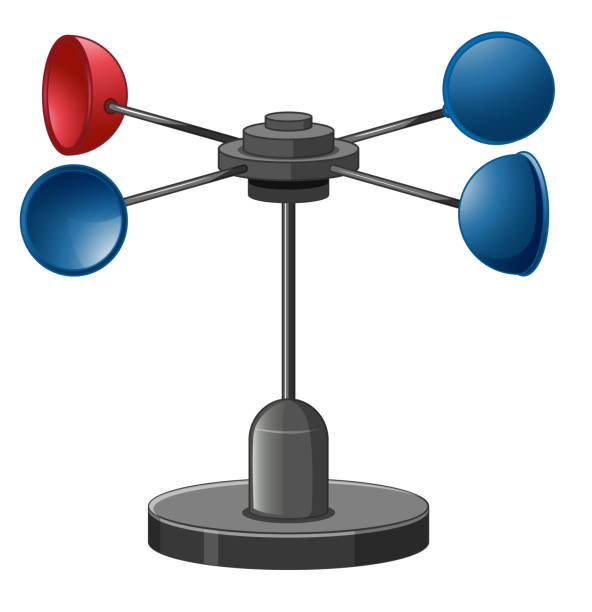How an Anemometer Can Boost Your Weather Monitoring System
How an Anemometer Can Boost Your Weather Monitoring System
Blog Article
Anemometers Revealed: Understanding Their Value in Ecological Tracking and Precaution
The role of anemometers in ecological tracking and safety measures is commonly undervalued, yet their importance is obvious. From meteorology to aeronautics safety and security, anemometers play an essential duty in offering exact data that educates decision-making procedures and enhances overall security.
Background of Anemometers
The evolution of anemometers can be traced back to the ancient civilizations where fundamental wind determining devices were first used. One of the earliest well-known anemometers was the hemispherical mug anemometer invented by Leon Battista Alberti in the 15th century.
In the 18th century, the prominent scientist John Thomas Romney Robinson introduced the Robinson anemometer, which featured 4 hemispherical mugs mounted on horizontal arms that prolonged from a main axis. This layout came to be a criterion in meteorological measurements because of its precision and integrity. Over the years, improvements in modern technology resulted in the advancement of more modern-day anemometers, consisting of ultrasonic anemometers and laser Doppler anemometers, offering increased precision and efficiency in measuring wind speed and direction. The history of anemometers showcases a remarkable journey of development and progress in the field of weather forecasting.
Kinds Of Anemometers
Throughout the area of meteorology, different types of anemometers have been developed to properly measure wind rate and instructions. Sonic anemometers use ultrasonic signals to gauge wind rate and direction properly. Hot-wire anemometers operate based on the principle that the cooling result of wind on a heated cable is symmetrical to the wind speed.
Applications in Weather Forecasting
Having actually talked about the different kinds of anemometers utilized in meteorology for determining wind speed and direction, it is necessary to discover their practical applications in the field. Anemometers play an important function in weather forecasting by giving exact and real-time information on wind problems (anemometer). Meteorologists make use of anemometers to monitor wind speed and direction to forecast weather patterns, problem cautions for serious climate occasions like hurricanes, tornados, and hurricanes, and assess climatic problems for aviation security
In weather forecasting, anemometers assist in comprehending local and regional wind patterns, which are important for predicting weather adjustments and establishing climatic patterns. These devices are also made use of in study to examine microclimates, urban warmth islands, and air contamination dispersion. Additionally, anemometers are used in agriculture to optimize plant administration practices, such as watering and pesticide application, based on wind problems.
Significance in Aviation Safety And Security
An indispensable element of ensuring aeronautics security hinges on the meticulous surveillance of wind problems utilizing anemometers. Anemometers play a vital function in aviation by giving real-time data on wind speed and instructions, assisting pilots in making notified decisions during touchdown, flight, and take-off. Strong and unforeseeable winds can substantially impact airplane operations, making it necessary for air travel authorities to rely on accurate wind dimensions to make certain the safety of travelers and crew.

In the dynamic setting of aviation, where also small modifications in wind rate and direction can have extensive results, anemometers stand as vital devices for promoting secure and secure flight.
Duty in Environmental Research
Anemometers play a crucial role in environmental research by providing important data on wind rate and direction. By properly gauging wind characteristics, anemometers aid researchers assess the activity of toxins in the air, analyze the influence of commercial exhausts, and forecast the spread of impurities in the environment.


Final Thought
To conclude, anemometers have actually played an important function in ecological tracking and precaution. With an abundant history and various kinds available, these gadgets have been extensively made use of in weather forecasting, air travel safety, and environmental research. Comprehending the importance of anemometers is necessary for accurately measuring wind speed and direction, which is essential for predicting weather condition patterns, making certain risk-free air travel procedures, and carrying out environmental studies - anemometer. Their contributions to these areas can not be taken too lightly.
One of the earliest recognized anemometers was the hemispherical mug anemometer designed by Leon Battista Alberti in the 15th century. Over the years, improvements in innovation led to the advancement of even more contemporary anemometers, consisting of ultrasonic anemometers and laser Doppler anemometers, providing raised accuracy and efficiency in determining wind speed and direction. Hot-wire anemometers run based on the principle that the cooling impact of wind on a warmed wire is symmetrical to the wind try this out rate. Meteorologists utilize anemometers to check wind speed and instructions to anticipate weather patterns, problem cautions for severe climate events like cyclones, tornadoes, and tornados, and analyze atmospheric conditions for air travel security.
Recognizing the significance of anemometers is vital for properly gauging wind rate and see here direction, which is vital for anticipating climate patterns, ensuring safe aviation operations, and carrying out ecological researches. (anemometer)
Report this page